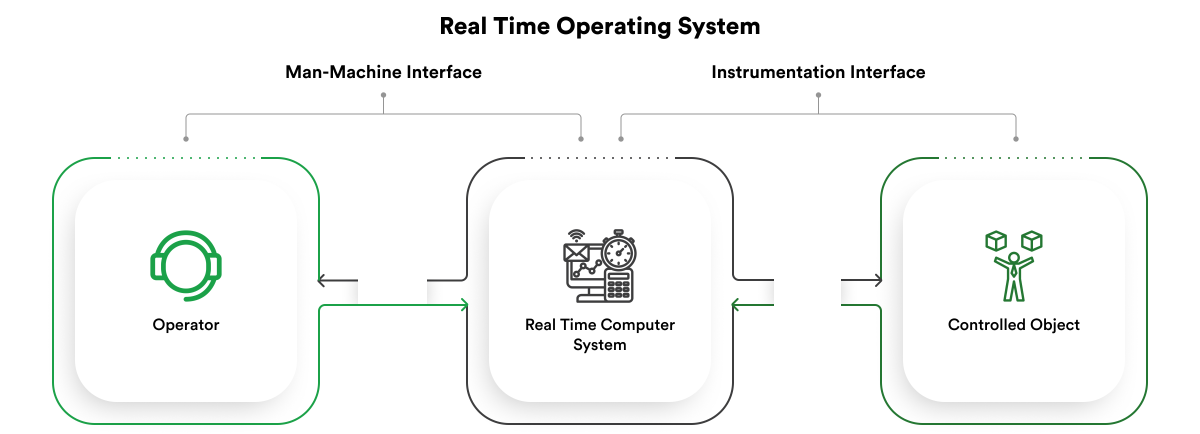Machine Learning and RTOS integration have gained traction as the need for intelligent and responsive embedded systems increases. Decision-making is being improved, predictive maintenance is made possible, and autonomous capabilities are driven by the smooth integration of ML algorithms, particularly those linked to deep learning, into RTOS systems.
This integration allows embedded systems to process and evaluate real-time data, adapt to and learn from their surroundings, and ultimately make intelligent decisions. Real-time operating systems (RTOS) are the silent architects of many industries, orchestrating flawless synchronization and unmatched accuracy in mission-critical applications.
Aerospace and defense. The aerospace and defense sectors use RTOS for avionics systems, satellite operations, crewless aerial vehicles (drones), missile systems, and radar systems. The predictable behavior of RTOS assures the successful completion of tasks necessary for these missions’ safety and success. Beyond the skies, RTOS is the hidden satellite industry hero because it makes precise data collection and connection with Earth possible. Unmanned aerial vehicles (drones) rely on RTOS for autonomous flight, mapping, and surveillance, and RTOS’s capacity to coordinate complex targeting and defense mechanisms powers missile and radar systems.
Agriculture. Automated irrigation systems and precision farming machinery powered by RTOS increase crop production and resource effectiveness. Automated irrigation systems that RTOS controls ensure crops get the proper water, reducing waste and enhancing crop yields. Precision farming equipment incorporating RTOS makes it possible to carry out operations accurately, including planting, fertilizing, and harvesting.
Automotive. In the automotive industry, RTOS is used in many different areas. Utilizing RTOS, Advanced Driver Assistance Systems (ADAS) can offer functions like lane departure warnings and accident prevention.
We at rinf.tech have recently developed a next-generation instrument cluster for one of the largest global brands in the automotive industry. Our solution illustrates how instrument clusters give drivers critical information through RTOS-driven displays. The smooth operation of infotainment systems, battery management for electric vehicles, and engine control units rely upon RTOS.
Consumer electronics. Delivering the best user experiences in consumer electronics is made possible by RTOS. For smooth and quick running, RTOS is used by smart home appliances, wearables like smartwatches and fitness trackers, and high-performance gaming consoles. An excellent user experience is provided by the smooth synchronization of various functionalities in consumer electronics, owing to RTOS. RTOS-driven high-performance gaming consoles, which go beyond smart homes and wearables by delivering outstanding graphics and immersive gameplay while ensuring quick responsiveness, push the frontiers of entertainment.
Energy. Smart grids and renewable energy control systems in the energy sector use RTOS to manage and distribute energy resources effectively. By adjusting to changing energy demands and distribution patterns, RTOS supports the efficient coordination of smart grids in the energy sector. RTOS makes it easier for renewable energy sources like solar and wind to be integrated into the grid as they gain popularity, enhancing energy efficiency and sustainability.
Finance and retail. RTOS offers a key foundation even in the financial and retail industries, where high-frequency trading systems require real-time operations. However, these systems frequently use specialized non-RTOS solutions due to their demanding specifications. Although they are specialized, high-frequency trading systems use the same real-time operating concepts as RTOS. These technologies make it possible to transfer money quickly, reacting to changes in the market with millisecond accuracy, ultimately driving efficient markets and influencing the world’s economies.
Healthcare and medical devices. Infusion pumps, respiratory equipment, and patient monitoring systems depend on the healthcare industry’s RTOS. These systems must be monitored and controlled in real-time to ensure patient safety. RTOS provides that infusion pumps are dependable and accurate, giving patients their drugs correctly. For respiratory patients, RTOS in the world of respiratory devices makes it possible to fine-tune oxygen levels. As healthcare devices become increasingly integrated and intelligent, RTOS is pivotal in enhancing patient care.
Industrial automation. RTOS is efficient for programmable logic controllers (PLCs), robot controllers, and supervisory control and data acquisition (SCADA) systems in industrial automation. With the help of RTOS, industrial operations may be precisely controlled and timed, increasing productivity. Supervisory control and data acquisition (SCADA) systems, which manage whole production processes, benefit from the influence of RTOS in industrial automation by increasing productivity and safety. Because of its crucial place in the industrial landscape, RTOS is positioned to be a key component of Industry 4.0, revolutionizing manufacturing through networked machines and real-time decision-making.
IoT. The Internet of Things (IoT) uses RTOS in connected devices, sensors, smart city infrastructure, and home automation systems to provide seamless connectivity and intelligent interactions. The function of RTOS in the Internet of Things extends to the infrastructure of smart cities, where it controls interconnected systems like intelligent lamps, waste collection, and traffic management. RTOS-enhanced home automation systems give consumers seamless control over every aspect of their living spaces, from lighting to security.
Telecommunications. To maintain stable and dependable communication networks, Telecommunications systems rely on RTOS for base station controllers, network switches, and routers. RTOS-driven base station controllers enable effective cellular networks to connect the entire world while addressing the constant demand for seamless and fast communication. In the meantime, RTOS-controlled network switches and routers smoothly route data packets while preserving the reliability of the world’s communication infrastructures.
Transportation and rail systems. Transportation and rail systems use RTOS for train control and traffic management, ensuring secure and effective transportation networks. RTOS-powered railway control systems guarantee passenger and freight safety, which helps improve train timetables, reduce delays, and increase overall transportation effectiveness. RTOS coordinates traffic lights, sensors, and data processing in traffic management to reduce congestion and improve urban mobility.








